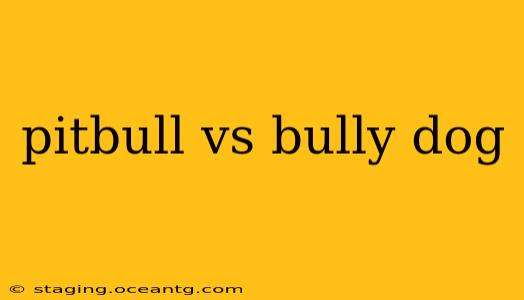The terms "Pitbull" and "Bully Dog" often get tossed around interchangeably, leading to confusion. However, they represent distinct concepts, and understanding the differences is crucial, especially for prospective dog owners. This article clarifies the distinctions between these terms, addressing common misconceptions and providing valuable insights.
What is a Pitbull?
The term "Pitbull" isn't a breed itself but rather an umbrella term encompassing several breeds with similar physical characteristics and a shared history of dogfighting. Breeds commonly grouped under the "Pitbull" label include:
- American Pit Bull Terrier (APBT): Often considered the foundation breed for many other types.
- American Staffordshire Terrier (AmStaff): Known for its muscular build and friendly disposition.
- Staffordshire Bull Terrier (Staffie): A smaller, more compact breed often described as having a playful personality.
- Other mixes: Many dogs referred to as "Pitbulls" are actually mixes of these breeds or mixes involving other breeds.
It's important to note that the physical appearance of dogs labeled "Pitbulls" can vary significantly due to this mixed ancestry. This variation contributes to the difficulty in accurately identifying a dog as a specific Pitbull breed without DNA testing.
What is a Bully Dog?
"Bully Dog" is even more of a catch-all term than "Pitbull." It's generally used to describe dogs with a stocky, muscular build, a broad head, and a powerful appearance. This descriptor encompasses a wide range of breeds, including (but not limited to):
- American Bulldogs: Larger than Pitbulls, with a more pronounced wrinkly face.
- Olde English Bulldogs: Similar to American Bulldogs but often with shorter snouts.
- French Bulldogs: Smaller, more compact breeds with a brachycephalic (short-nosed) face.
- American Pit Bull Terriers, American Staffordshire Terriers, and Staffordshire Bull Terriers: These breeds, which are also considered Pitbulls, are frequently included in the umbrella term “Bully Breed.”
Essentially, a "Bully Dog" is a dog that fits a specific physical profile, not a specific breed designation.
What are the Key Differences?
The primary difference lies in the definition:
- Pitbull: Refers to a specific group of breeds with a shared lineage and history.
- Bully Dog: A more general term encompassing various breeds based on physical characteristics.
A dog can be both a Pitbull and a Bully Dog, but a Bully Dog is not necessarily a Pitbull.
Are Pitbulls and Bully Dogs Aggressive?
This is a crucial point often fueled by misconceptions. Neither "Pitbull" nor "Bully Dog" inherently indicates aggression. A dog's temperament is primarily shaped by factors like genetics (individual variation within breeds), socialization, training, and experiences. Any breed, including those labelled as "Pitbulls" or "Bully Dogs," can exhibit aggressive behavior if poorly socialized, inadequately trained, or subjected to abuse or neglect. Responsible ownership, including early socialization and consistent training, is vital for any dog, regardless of breed.
What about Breed-Specific Legislation?
Many jurisdictions have breed-specific legislation (BSL) targeting dogs often labeled "Pitbulls." These laws vary widely in their definitions and enforcement, often leading to legal challenges and difficulties for owners. These laws tend to focus on physical characteristics, making accurate identification challenging and potentially leading to misidentification of dogs who don't actually fall within the intended scope of the legislation.
How Can I Identify a Dog's Breed?
Accurate breed identification can be tricky, especially with mixed breeds. DNA testing is the most reliable method. However, a veterinarian or experienced dog breeder can also offer insights based on physical characteristics. Visual identification alone is often unreliable, particularly given the wide variation in appearance within and between breeds often classified as Pitbulls or Bully Dogs.
Conclusion
The terms "Pitbull" and "Bully Dog" often create confusion. Understanding that "Pitbull" refers to a specific group of breeds while "Bully Dog" describes a body type is crucial. Remember that a dog's temperament is not determined by breed alone but by a complex interplay of various factors. Responsible ownership and proper training are essential for all dogs, regardless of breed or appearance.
